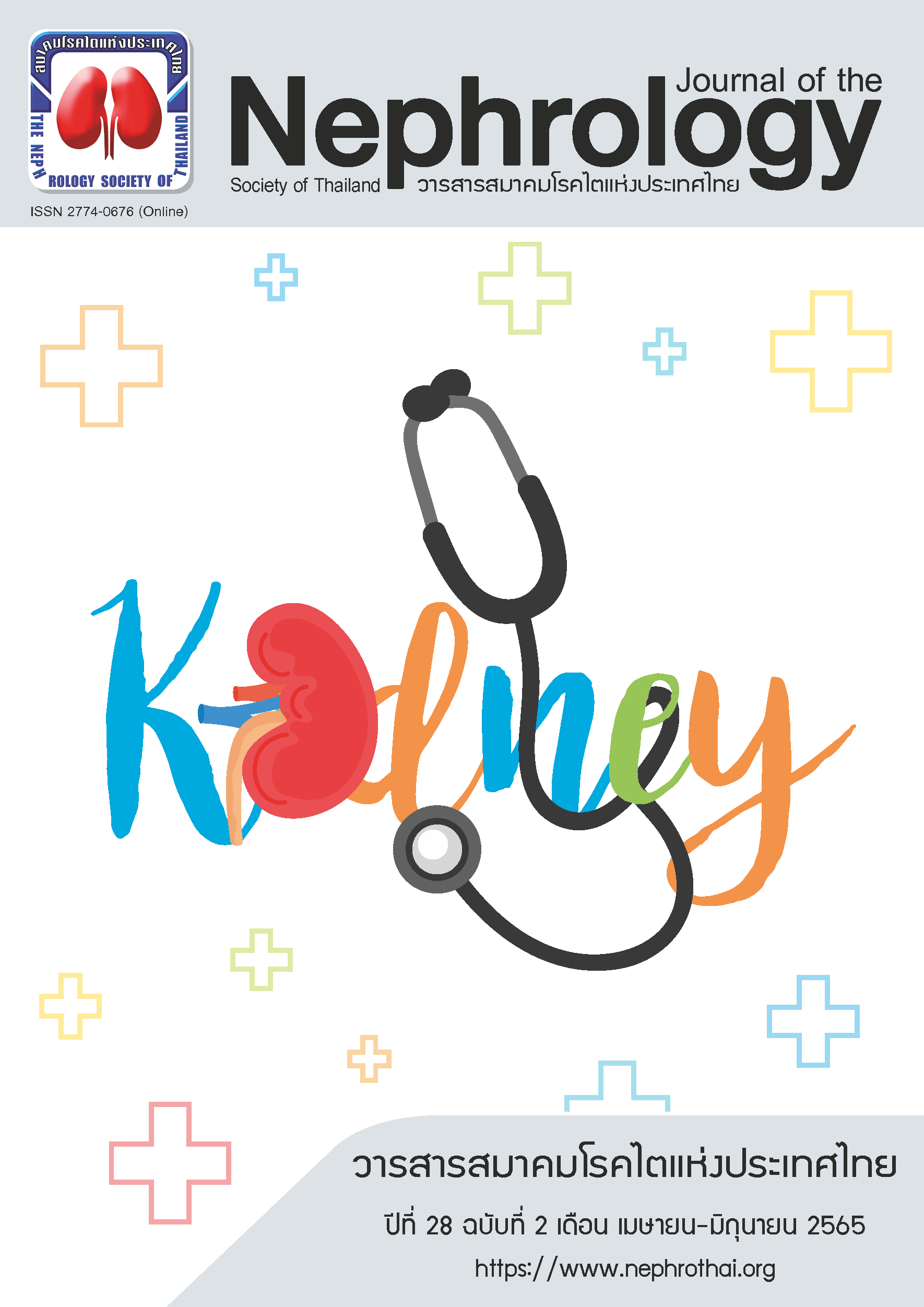ยาขับปัสสาวะและการประยุกต์ใช้ทางคลินิก
Main Article Content
บทคัดย่อ
ยาขับปัสสาวะ หมายถึง ยาที่ออกฤทธิ์เพิ่มปริมาณปัสสาวะ ส่วนใหญ่ออกฤทธิ์ยับยั้งการดูดกลับโซเดียมที่ตำแหน่งต่าง ๆ ของท่อไต บางชนิดออกฤทธิ์ยับยั้งการดูดกลับน้ำหรือเพิ่มปริมาณตัวทำละลายในปัสสาวะ เมื่อร่างกายได้รับยาขับปัสสาวะและสูญเสียสารน้ำไปจะมีการปรับตัวเพิ่มการดูดกลับโซเดียมเพื่อลดการตอบสนองต่อยาขับปัสสาวะ ดังนั้นควรจำกัดการบริโภคเกลือร่วมด้วยเสมอ นอกจากนี้โรคหรือภาวะผิดปกติของร่างกายหลายอย่างส่งเสริมให้เกิดการดื้อต่อยาขับปัสสาวะมากขึ้น ยาขับปัสสาวะแต่ละชนิดมีคุณสมบัติที่แตกต่างกันจึงถูกนำมาใช้ทางคลินิกด้วยข้อบ่งชี้ที่หลากหลาย ยากลุ่ม loop diuretics เป็นยาที่มีประสิทธิภาพสูงสุดในการขับปัสสาวะจึงเป็นยาหลักในการรักษาภาวะสารน้ำในร่างกายเกินในผู้ป่วยหัวใจวาย การเพิ่มประสิทธิภาพในการขับปัสสาวะสามารถทำได้หลายวิธีทั้งการเพิ่มขนาดยา การบริหารยาวันละหลายครั้ง รวมถึงการใช้ยาขับปัสสาวะหลายชนิดร่วมกัน นอกจากนี้ยาขับปัสสาวะยังถูกใช้เป็นยาลดความดันโลหิตโดยไปออกฤทธิ์ขับเกลือและสารน้ำในร่างกาย ถึงแม้การใช้ยาขับปัสสาวะจะไม่สามารถป้องกันหรือรักษาภาวะไตวายเฉียบพลันได้ แต่ก็ยังมีประโยชน์ในการจัดการภาวะสารน้ำเกิน และสามารถนำมาใช้พยากรณ์ความจำเป็นต้องบำบัดทดแทนไตในผู้ป่วยไตวายเฉียบพลันได้ ส่วนในผู้ป่วยโรคไตเรื้อรังรวมถึงผู้ป่วยที่บำบัดทดแทนไตแล้ว ยาขับปัสสาวะช่วยขจัดสารน้ำในร่างกายและถนอมปัสสาวะที่เหลืออยู่ได้ แต่ไม่ช่วยเพิ่มการขจัดของเสีย กลุ่มอาการเนฟโฟรติกจะตอบสนองต่อยาขับปัสสาวะได้ไม่ดีเนื่องจากภาวะแอลบูมินในเลือดต่ำและแอลบูมินรั่วในปัสสาวะ การให้แอลบูมินทางหลอดเลือดดำร่วมด้วยสามารถเพิ่มประสิทธิภาพของยาขับปัสสาวะได้โดยเฉพาะในรายที่ระดับแอลบูมินในเลือดต่ำมาก โดยสรุป ยาขับปัสสาวะเป็นยาที่ใช้บ่อยและมีประโยชน์ในการรักษาผู้ป่วยได้หลายโรค ขณะเดียวกันยาขับปัสสาวะก็ก่อให้เกิดผลข้างเคียงได้บ่อยเช่นกัน แพทย์จึงควรมีความรู้ความเข้าใจเกี่ยวกับยาขับปัสสาวะเป็นอย่างดี
Article Details

อนุญาตภายใต้เงื่อนไข Creative Commons Attribution-NonCommercial-NoDerivatives 4.0 International License.
บทความนี้ตีพิมพ์ภายไต้การอนุญาต CC BY-NC-ND 4.0 ซึ่งอนุญาตให้สามารถใช้บทความนี้พื่อวัตถุประสงค์ใดๆ ก็ตามที่ไม่ใช่เชิงพาณิชย์ โดยต้องมีการอ้างถึงที่มาของบทความอย่างครบถ้วน ใครก็ตามสามารถคัดลอกและแจกจ่ายทุกส่วนของบทความนี้โดยไม่ต้องขออนุญาตจากผู้ประพันธ์หรือสมาคมโรคไตแห่งประเทศไทย
เอกสารอ้างอิง
Hoorn EJ, Wilcox CS, Ellison DH. Diuretics. In: Yu AS, Chertow GM, Luyckx VA, Marsden PA, Skorecki K, Taal MW, editors. Brenner & Rector’s the Kidney. 11th ed. Philadelphia: Elsevier; 2020. p. 1708-40.
Ellison DH. Clinical pharmacology in diuretic use. Clin J Am Soc Nephrol. 2019;14(8):1248-57.
Ellison DH, Felker GM. Diuretic treatment in heart failure. N Engl J Med. 2017;377(20):1964-75.
Felker GM, Lee KL, Bull DA, Redfield MM, Stevenson LW, Goldsmith SR, et al. Diuretic strategies in patients with acute decompensated heart failure. N Engl J Med. 2011;364(9):797-805.
Maaten JM, Valente MA, Damman K, Hillege HL, Navis G, Voors AA. Diuretic response in acute heart failure-pathophysiology, evaluation, and therapy. Nat Rev Cardiol. 2015;12(3):184-92.
Sica DA. Diuretic use in renal disease. Nat Rev Nephrol. 2011;8(2):100-9.
Mullens W, Damman K, Harjola VP, Mebazaa A, Brunner-La Rocca HP, Martens P, et al. The use of diuretics in heart failure with congestion - a position statement from the Heart Failure Association of the European Society of Cardiology. Eur J Heart Fail. 2019;21(2):137-55.
Frea S, Pidello S, Volpe A, Canavosio FG, Galluzzo A, Bovolo V, et al. Diuretic treatment in high-risk acute decompensation of advanced chronic heart failure-bolus intermittent vs. continuous infusion of furosemide: a randomized controlled trial. Clin Res Cardiol. 2020;109(4):417-25.
Alqahtani F, Koulouridis I, Susantitaphong P, Dahal K, Jaber BL. A meta-analysis of continuous vs intermittent infusion of loop diuretics in hospitalized patients. J Crit Care. 2014;29(1):10-7.
Jentzer JC, DeWald TA, Hernandez AF. Combination of loop diuretics with thiazide-type diuretics in heart failure. J Am Coll Cardiol. 2010;56(19):1527-34.
Konstam MA, Gheorghiade M, Burnett JC, Jr., Grinfeld L, Maggioni AP, Swedberg K, et al. Effects of oral tolvaptan in patients hospitalized for worsening heart failure: the EVEREST Outcome Trial. JAMA. 2007;297(12):1319-31.
ALLHAT Officers and Coordinators for the ALLHAT Collaborative Research Group. Major outcomes in high-risk hypertensive patients randomized to angiotensin-converting enzyme inhibitor or calcium channel blocker vs diuretic: The Antihypertensive and Lipid-Lowering Treatment to Prevent Heart Attack Trial (ALLHAT). JAMA. 2002;288(23):2981-97.
Whelton PK, Carey RM, Aronow WS, Casey DE, Jr., Collins KJ, Dennison Himmelfarb C, et al. 2017 ACC/AHA/AAPA/ABC/ACPM/AGS/APhA/ASH/ASPC/NMA/PCNA Guideline for the prevention, detection, evaluation, and management of high blood pressure in adults. J Am Coll Cardiol. 2018;71(19):e127-e248.
Williams B, Mancia G, Spiering W, Agabiti Rosei E, Azizi M, Burnier M, et al. 2018 ESC/ESH Guidelines for the management of arterial hypertension. Eur Heart J. 2018;39(33):3021-104.
สมาคมความดันโลหิตสูงแห่งประเทศไทย. แนวทางการรักษาโรคความดันโลหิตสูงในเวชปฏิบัติทั่วไป พ.ศ. 2562.เชียงใหม่: สำนักพิมพ์ ทริค ธิงค์; 2562.
Unger T, Borghi C, Charchar F, Khan NA, Poulter NR, Prabhakaran D, et al. 2020 International Society of Hypertension Global hypertension practice guidelines. Hypertension. 2020;75(6):1334-57.
Williams B, MacDonald TM, Morant S, Webb DJ, Sever P, McInnes G, et al. Spironolactone versus placebo, bisoprolol, and doxazosin to determine the optimal treatment for drug-resistant hypertension (PATHWAY-2): a randomised, double-blind, crossover trial. Lancet. 2015;386(10008):2059-68.
Kidney Disease: Improving Global Outcomes (KDIGO) Acute Kidney Injury Work Group. KDIGO Clinical practice guidelines for acute kidney injury. Kidney int. 2012;120(2):1–138.
Ho KM, Power BM. Benefits and risks of furosemide in acute kidney injury. Anaesthesia. 2010;65(3):283-93.
Chawla LS, Davison DL, Brasha-Mitchell E, Koyner JL, Arthur JM, Shaw AD, et al. Development and standardization of a furosemide stress test to predict the severity of acute kidney injury. Crit Care. 2013;17(5):R207.
Koyner JL, Davison DL, Brasha-Mitchell E, Chalikonda DM, Arthur JM, Shaw AD, et al. Furosemide stress test and biomarkers for the prediction of AKI severity. J Am Soc Nephrol. 2015;26(8):2023-31.
Bragg-Gresham JL, Fissell RB, Mason NA, Bailie GR, Gillespie BW, Wizemann V, et al. Diuretic use, residual renal function, and mortality among hemodialysis patients in the Dialysis Outcomes and Practice Pattern Study (DOPPS). Am J Kidney Dis. 2007;49(3):426-31.
Medcalf JF, Harris KP, Walls J. Role of diuretics in the preservation of residual renal function in patients on continuous ambulatory peritoneal dialysis. Kidney Int. 2001;59(3):1128-33.
Duffy M, Jain S, Harrell N, Kothari N, Reddi AS. Albumin and furosemide combination for management of edema in nephrotic syndrome:a review of clinical studies. Cells. 2015;4(4):622-30.
Kitsios GD, Mascari P, Ettunsi R, Gray AW. Co-administration of furosemide with albumin for overcoming diuretic resistance in patients with hypoalbuminemia: a meta-analysis. J Crit Care. 2014;29(2):253-9.


